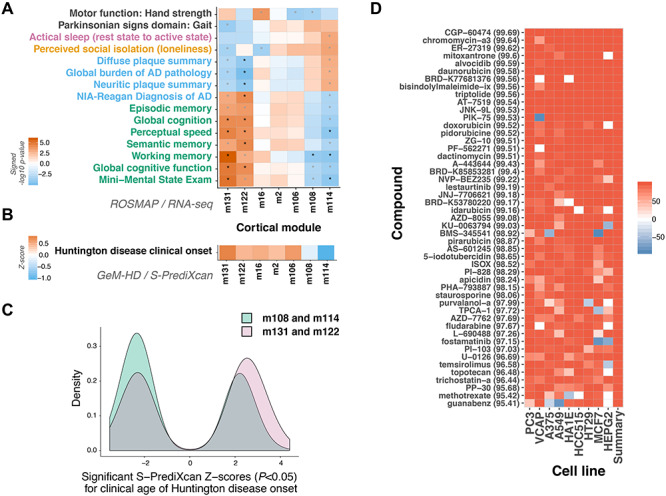Figure 5.

Expression of a subset of cortical gene coexpression modules influences the clinical onset of Huntington disease (HD) as well as related phenotypes. (A) Cortical coexpression modules that show enrichments for TWAS results for HD clinical age of onset (n = 7) are also associated with relevant phenotypes in an independent longitudinal aging cohort. Increased expression of mitochondrial-related modules m122 and m131 is associated with improved performance for cognitive-related traits, whereas the opposite effect was observed for m108 (cholesterol and hedgehog signaling-related) and m114 (cadherin binding-related) expression. Within-category Bonferroni significant traits are displayed, with asterisks denoting significant associations after Bonferroni correction for multiple testing. Trait categories are annotated (black, motor and gait; pink, sleep and circadian rhythms; orange, lifestyle/personality; blue, pathology; green, cognitive decline). Black asterisks: significant after correcting for all comparisons, grey asterisks: significant after adjusting for within-trait comparisons. (B) A similar effect pattern was observed for these modules with regard to their influence on age of clinical onset in HD. When assessing significant S-PrediXcan Z-scores (i.e. P < 0.05), on average, increased expression of genes belonging to modules m108 and m114 is more likely to lead to an earlier age of HD onset, whereas the opposite pattern (i.e. increased expression and later onset) is observed for the other modules. (C) Collectively, significant HD clinical onset S-PrediXcan Z-scores for the top phenotype-related coexpression cortical modules also display differences in distributions. There were significantly more negative Z-scores detected for genes belonging to modules m108 and m114 compared with m131 and m122 (P = 2.0 × 10−6). (D) A screen of over 27 000 perturbagens in nine cell lines identified highly similar (>95%) perturbagens in the Broad Connectivity Map database (median Connectivity Map/tau scores indicated in parentheses). Similar compounds, with potential use for drug repurposing in HD, are shown.
